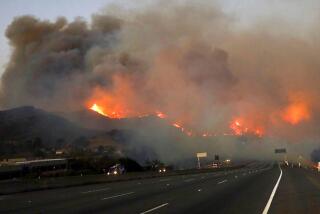Support Tax Proposal
- Share via
Public hearings ended earlier this month on a proposal to place before the voters in November a half-cent sales tax increase to support major expansion of San Diego County’s network of highways, local streets and rail lines.
As might be expected of a plan that first has to win the backing of 18 cities, county government and local transportation agencies, and then face voters countywide, the proposal bears the unmistakable mark of compromise--in fact, compromises within compromises.
Visionaries who would like to see hundreds of millions of dollars spent to give San Diego the kind of commuter rail system several eastern cities have and Los Angeles wants will be sorely disappointed. So will those who believe spending money on mass transit is a waste when money is so badly needed for highways and streets. This plan has something for everybody: a third of the money collected over the next 20 years would go to expand and improve highways, a third for local streets, a third for mass transit.
While not every city or every neighborhood would get a new construction project, most would be directly affected by at least one. Highway expansions would include widening California 78 and California 76 in North County, building California 56 from Del Mar to Poway, building California 125 from Lemon Grove to National City and extending California 52 from Interstate 15 to Santee.
Rail projects would include extending the San Diego Trolley from downtown to La Mesa, from El Cajon to Santee and from downtown to the Golden Triangle. A rush-hour commuter line running between Oceanside and downtown San Diego, and between Oceanside and Escondido also would be created using existing Santa Fe railroad tracks.
Individual cities and the county would set their own priorities for street projects within their jurisdictions.
This package contains several major improvements that would make getting around the county during the last decade of this century and well into the next a lot easier than it is otherwise likely to be. It is not a free ride, of course, and the price is an extra half-cent sales tax collected for the next 20 years. The tax is expected to raise $2.1 billion over that time.
Because the transportation measure is being proposed under the auspices of Sandag, the regional council of governments, it has the advantage of needing only a simple majority to pass, rather than the two-thirds vote usually required for a tax increase. A potential difficulty, on the other hand, is that the City of San Diego looks as if it will place on the same ballot bond issues for the improvement of Balboa and Mission Bay parks as well as a measure to allow it to override the state Gann spending limit.
After four public hearings on the plan, the Sandag board will probably vote this month to place the referendum on the November ballot. The major objections have been raised by environmentalists who, among other things, object to the construction of California 56. We have some sympathy for their viewpoint. But on the whole this is a good plan that, if passed, would improve life here.
More to Read
Sign up for Essential California
The most important California stories and recommendations in your inbox every morning.
You may occasionally receive promotional content from the Los Angeles Times.













